 |
| The Independent Traveler's Newsletter PAGE FOUR |
 |
| The Independent Traveler's Newsletter PAGE FOUR |
|
The
Limousin region
Limousin (pronounced lee moo zah [n]) is one of two regions, the other being Auvergne, totally in the Massif Central, the elevated middle of southern France made up of mountains and plateaus and covering 15 percent of the country. Other regions are partially in the Massif Central to the south and east. The Massif Central's relative inaccessibility ended with the completion of the A75 autoroute in December of 2010, six months ahead of schedule. That inaccessibility most likely discouraged tourists and kept the population density of the Massif one of the lowest in France. However, the A20 autoroute (known as 'L'Occitane') passes directly through the Haute-Vienne, giving travelers easy access to that département. 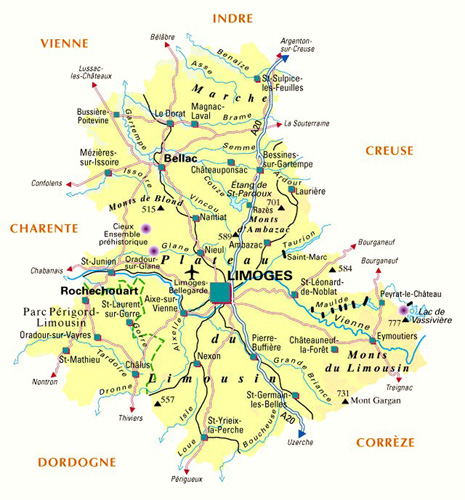 The Rochechouart crater at the western edge of Limousin is said to have been caused over 200 million years ago by a meteorite, but erosion has obliterated most of it. There is no evidence of past volcanic activity here, but the same cannot be said for the neighboring Auvergne region to the east. Rivers are important resources in the Limousin, and it is crossed by three major ones: the Vienne, Dordogne and the Charente, the latter having its source in the Haute-Vienne near the village of Chéronnac southwest of Rochechouart. Beginning as a trickle, with many debating its actual starting point, the Charente becomes a wide, often flood-prone river and flows for 237 miles to empty into the Atlantic near Rochefort. The Charente is the fifth longest river in France. Limousin is known for its high-quality drinking water and excellent fishing, and many minor rivers course through the region as shown on this map; one of the loveliest and a favorite of ours is the Gartempe, a tributary of the River Creuse. 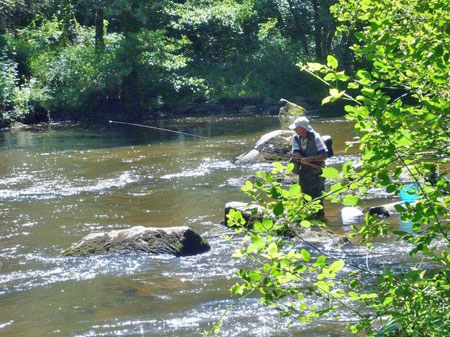 Fishing in the River Gartempe THE HAUTE-VIENNE 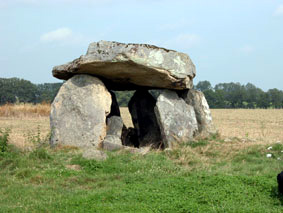 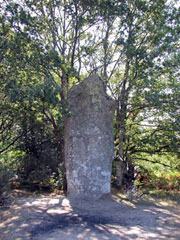 The Haute-Vienne is very
rural and a great destination for
outdoor adventures such as hiking, climbing, biking, horseback riding,
boating and exploring. Paleolithic and Mesolithic remains have
been found here: dolmens, standing stones, burial chambers, bronze-age
artefacts and more. There are several foothill ranges of
the
Massif Central in Haute-Vienne. The first is the Monts de Blond, a small range
of mountains that is home to an incredible collection of dolmens (two
or more upright stones with a capstone shown in left photo) and menhirs
(large standing
stones shown in right photo). Huge boulders washed down from the
hillsides by erosion
and floods, making it possible for prehistoric man to create these
megaliths. Click on the Monts de Blond link and follow in the
footsteps of Henri IV to the tiny
hamlet of Montrol Sénard. Other foothill ranges in the
département are Monts d'Ambazac, the Monts de Chalus, and the Monts du Limousin. The Haute-Vienne is very
rural and a great destination for
outdoor adventures such as hiking, climbing, biking, horseback riding,
boating and exploring. Paleolithic and Mesolithic remains have
been found here: dolmens, standing stones, burial chambers, bronze-age
artefacts and more. There are several foothill ranges of
the
Massif Central in Haute-Vienne. The first is the Monts de Blond, a small range
of mountains that is home to an incredible collection of dolmens (two
or more upright stones with a capstone shown in left photo) and menhirs
(large standing
stones shown in right photo). Huge boulders washed down from the
hillsides by erosion
and floods, making it possible for prehistoric man to create these
megaliths. Click on the Monts de Blond link and follow in the
footsteps of Henri IV to the tiny
hamlet of Montrol Sénard. Other foothill ranges in the
département are Monts d'Ambazac, the Monts de Chalus, and the Monts du Limousin.
ECONOMICALLY . . . The primary source of income in the Limousin is agriculture, with Haute-Vienne earning the majority from its Limousin cattle with their distinctive golden-red color, sheep, pigs, goats and a thriving dairy industry. Organic food is widely grown in Limousin ~ and over a million hectares of cereals in 2013. You will enjoy fresh, locally-grown organic fruits and vegetables, as well as dairy products and meat from organically raised, grass-fed livestock, and a wide variety of fish in the area restaurants. The markets draw great shopping crowds because of the regional focus on organic, healthy and sustainable products. 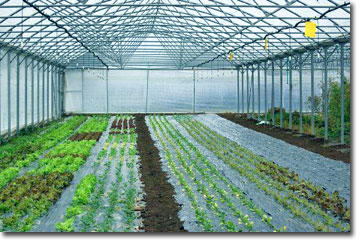 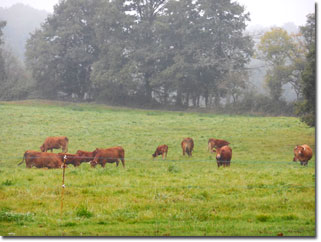 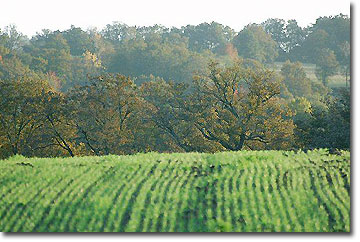 Organic produce in greenhouses,
organically raised Limousin cattle and fields of organic vegetables at Château du Fraisse
in Nouic, Haute-Vienne.
This château is also a charming, historic bed & breakfast and wedding venue that will celebrate 800 years in the same family in 2020! 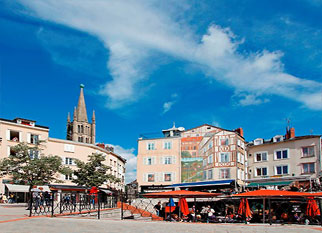 The cuisine of the Limousin focuses on natural products with meat being quite important. However, Goutte du Limousin, a soft goat cheese is one of their specialties. Many visitors to France find great enjoyment in the covered and open air markets in the towns and villages. Farmers and craftspeople bring their goods and set up their booths at the crack of dawn, and shoppers are soon filling the streets. The Haute-Vienne has markets at all days of the week in the morning, some of which are Ambazac on Fridays, Bellac on Wednesday, Blond on Sunday, Châteauponsac on Friday, Saturday, and Sunday, Limoges different days at various locations but every day at place de la Motte [shown in this photo], Mortemart on Sundays from June to September, Oradour s/Vayres on Thursday, Rochechouart on Tuesday, Friday and Saturday, and St-Junien on Thursday, Friday, Saturday and Sunday. The Limousin also plays an important part in the French wine industry due to its forests of exceptional French oak, admired for its unique characteristics and flavors imparted during wine fermentation. Vintner Rémy Martin (cognac) actually has been in a partnership with the French oak industry that has survived more than one hundred years. Whiskey producers in Scotland and Ireland also use Limousin oak for their barrels as French oak is prized for its quality. More importantly for the environment and those needing oak for their barrels, the French, unlike most countries, have done an excellent job of managing their forests since World War II, something they had done equally as well in the previous centuries. About one quarter of France is forest having 40% of all the forests in Europe, and of that, one third are oak trees. HISTORICALLY . . . We have read that visiting Limousin is like stepping back decades in time. But, we are interested in going back even further. As mentioned above, Château du Fraisse has been in the same family since 1220, something almost impossible to fathom. The original château was set ablaze by the Black Prince (the Prince of Wales) in 1356 and rebuilt in the 15th century by Jacques des Monstiers, an ancestor of today's owners, following the Hundred Years War. And the region experienced and suffered much more over the centuries. 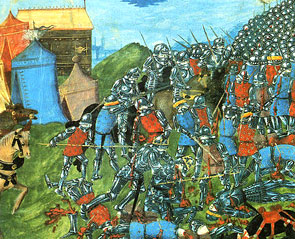 It was the Romans who discovered there was gold and tin to be mined here and, of course, they introduced grapes to the region. Amphorae, large, two-handled storage jars for wine and oil, have been found at Saint-Gence, a commune about 16 kilometers northwest of Limoges. Roman roads led to Brittany, through the Rhône Valley and south to the Mediterranean. When the Barbarians invaded, the region experienced a marked decline. The migration of the Barbarians (a general term for eight groups of migrating peoples) lasted from the third-quarter of the 4th century until about 800 AD at the beginning of the Early Middle Ages. Clovis I took control of Limousin following the battle of Vouillé in 507 in the neighboring Vienne. He became the King of the Franks and united the Frankish tribes under one ruler and to pass the kingship down to heirs. This was the start of the Merovingian dynasty which lasted in France for 200 years. He converted to Christianity in 496 at the encouragement of his wife. Clotilde, who later received sainthood for this act. By 674, this region became part of the Duchy of Aquitaine and the Viscount of Limoges was created. This is a painting done in the 15th century showing Clovis' battle at Vouillé when he, presumably, killed Alaric II, King of the Visigoths. The Visigoths gradually deteriorated as Alaric's heirs attempted to assume their duties or were unable to do so. 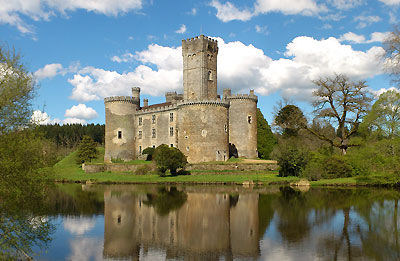
Richard had been mortally wounded at nearby Chalus, and reports say that he either died there or at Montbrun. It is not really known for sure. He probably died in his tent in front of the Château de Châlus-Chabrol, and his entrails were buried in that chapel. His embalmed heart, however, was buried in the Rouen cathedral with the remainder of his body entombed at the Abbaye de Fontevraud in Anjou, Pays de la Loire, where his father Henry II of England and mother, Eleanor of Aquitaine, are buried. This region was involved in the Hundred Years War, after which France granted England a large swath of Limousin. The city of Limoges rebelled and gave its allegiance to the French crown and was thereby sacked in 1370. Years later, the economy improved with tanneries, paper mills and the printing industry growing in the city. The region became known for its fine enamel work. Henri IV brought peace and prosperity to the Limousin, visited Limoges in 1607, and was enthusiastically welcomed. The biggest news for Limoges took place in 1765: kaolin, a clay mineral necessary for the production of porcelain, was discovered near Saint-Yireix-la-Perche, and the porcelain industry was born. During the French Revolution, the Haute-Vienne département came into being, taking its name from the upper Vienne River which flows into it from the adjoining Corrèze département. It was 1790, and it was assigned the département number 81, later changed to 87 in the 19th century when land to the east and northeast was added. Recent history reminds us that the Vichy line dividing France in World War II can be found in Limousin, and the maquis freedom fighters helped airmen from hideouts here to swim river boundaries into Free France. Some small villages have street names honoring uprising dates, and there are Resistance museums in both Limoges and Brives. The Limousin continued to have abundance during World War II. We would like to take the liberty to quote from the book, The Politics of Everyday Life in Vichy France: Foreigners, Undesirables and Strangers by Shannon L. Fogg of the Missouri University of Science and Technology [published 2009, Cambridge University Press]. "The departments of Haute-Vienne and Creuse welcomed large refugee populations during the war, as Third Republic officials designated the Haute-Vienne as one of the first departments to receive evacuated Alsatians." "The area's rich food production encouraged some refugees to remain in the region rather than returning to urban cities occupied by German troops where shortages were more severe. Residents of other departments in the unoccupied zone also traveled to the Limousin to purchase vegetables and other farm products, and relatives living in cities wrote to family members still living on the farm and asked them to send food." CITIES, TOWNS AND VILLAGES . . . LIMOGES Limoges was named Augustoritum during the reign of Augustus Caesar and located strategically on the River Vienne. Until this past January, Limoges, world-renowned for its porcelain, was the capital of Limousin Many outside the region may not be aware that Limoges is also a leader in electric equipment manufacture ~ having used porcelain as an insulator in the past ~ although the number of large factories has dwindled. 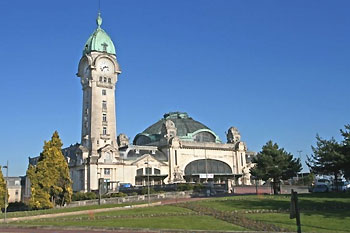 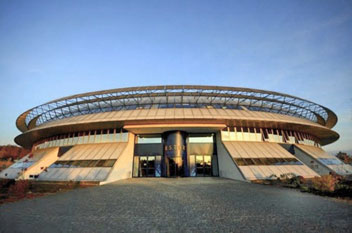 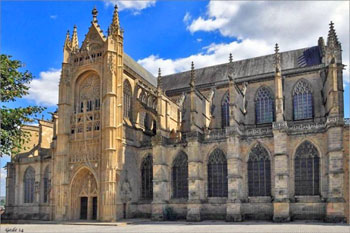 Monuments of Limoges: St-Benedictins Railway Station, the ESTER Science Park, and the St-Etienne Cathedral Take the Little Train while in Limoges to be sure to see all the monuments and interesting neighborhoods ~ from the Flamboyant Gothic portal of St-Etienne Cathedral whose construction began in 1273 and was completed in the late 1800s, to the modern, circular ESTER Science Park built in 1993 specializing in biotech, industrial ceramics. water treatment, optics and electronics of the 21st century. There is the striking Benedictins Rail Station, built on the former site of a convent, with its copper dome, 61 meter high clock tower and Art Déco stained glass windows. Built in 1929, it is the pride and joy of the locals. 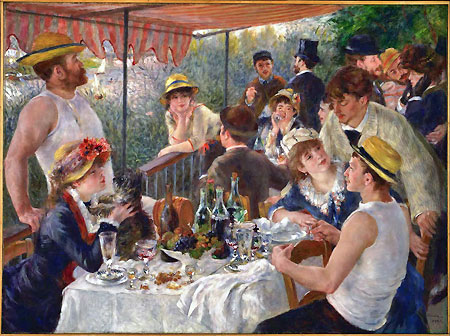 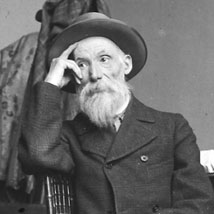 Limoges also has the distinction of being the birthplace in 1841 of Pierre-Auguste Renoir, the renowned Impressionist. His family moved to Paris when he was young, and he became one of the most beloved painters of his day. He worked alongside Claude Monet, who had become his close friend, but he is probably best known for his paintings of Parisian leisure life in the last third of the 19th century. Renoir was admired for his color palette and had an eye for the use of light and shadow in his paintings. He died in Cagnes-sur-Mer near Nice in southern France in 1919 at the age of 78. This is probably his most famous painting: Luncheon of the Boating Party, 1881. . . . continued on page five |
|
 previous
page
next page previous
page
next page |